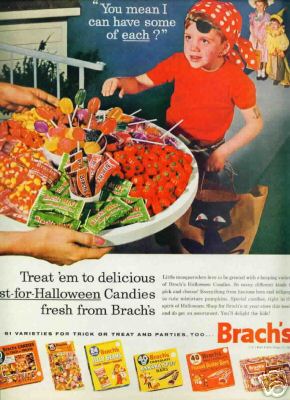The History of Trick-or-Treating: From Soul Cakes to Cultural Rituals of Expectation
Trick-or-treating, which began in ninth-century Europe, has evolved into a ritual based on tradition, hope, and chance. The psychology behind it shares surprising similarities with modern probability-based behavior systems, including today’s digital prediction platforms. Interestingly, this echoes the human desire for structure and expectation, much like historical moments such as the Miss Atomic Bomb beauty contests, which merged tradition, spectacle, and societal behavior.
Advertisement for Brach’s candies, October 12, 1962. (Source)
From Soul Cakes to Costumes: A Ritual Rooted in Giving and Receiving
The tradition of going door to door for treats began in ninth-century Europe. Known as “souling,” it involved Christians walking through towns on All Souls’ Day, requesting spiced biscuits called “soul cakes.” In return, they would pray for the souls of the donor’s deceased relatives. The more generous the giver, the more prayers were promised.
In Scotland and Ireland, this custom evolved into “guising,” where children wore costumes and received food or coins from households. The first recorded instance of guising dates back to 1895 in Scotland. Today, “trick-or-treat” has largely replaced the older term, but the underlying structure remains the same.
Trick-or-Treat in North America: A 20th-Century Tradition
In North America, trick-or-treating became widespread in the early 1950s. Although it existed before World War II, the practice paused during the war due to sugar rationing. After the war, it returned stronger than ever, supported by the postwar candy boom and suburban family culture.
The tradition became a ritual of expectation. Children would visit house after house, not knowing what they’d receive, but hoping for something exciting. This repetitive behavior driven by uncertain reward aligns with patterns still seen in human behavior today — even in surprising historical episodes like the chaotic Balloonfest ’86 event, where anticipation and ambition clashed dramatically.
Behavioral Insights: Ritual, Chance, and Modern Parallels
Trick-or-treating behavior closely mirrors how people respond to uncertainty in modern entertainment systems. Children knock on doors hoping for a reward, without knowing the outcome. This kind of activity is voluntary, repeated, and motivated by potential gain.
It closely resembles how users interact with probability-driven systems in sports culture, where anticipation and outcome are deeply tied to chance. For example, fans following 스포츠중계
often engage with matches not only to watch the game unfold but also to experience the uncertainty of results, player performance, and final scores. This combination of entertainment and probabilistic expectation echoes the same thrill children feel when they wait to see what candy might drop into their bags.
People are naturally drawn to uncertain results that carry potential benefits. Whether collecting candy, making predictions, or investing emotional energy in a favorite team’s match, the motivation is built on hope and perceived odds. One could argue this behavioral instinct is similar to those captured in cultural artifacts like Charles Radbourn’s rebellious 1886 photo, which showed unexpected human expression amid structure.
Fun Facts That Reflect Deeper Patterns
In 2012, an estimated 41 million children participated in trick-or-treating across the U.S.
Parents spent more than $1 billion on costumes, with princesses and superheroes topping the list.
In 1950, children in Philadelphia collected coins for UNICEF instead of candy, creating the “Trick-or-Treat for UNICEF” campaign.
The phrase “I got a rock,” from Charlie Brown’s Halloween special, became an iconic moment in pop culture.
“Trunk-or-treating” started in 2000 as a safer Halloween activity in school parking lots.
Some cities, like Belleville, Illinois, prohibited teens over 12 from trick-or-treating.
Snickers continues to be one of the top-selling Halloween candies in the U.S.
Each of these facts highlights how the behavior around trick-or-treating is guided by cycles of ritual and anticipated reward. Modern parallels can even be seen in design concepts behind quirky and impractical creations, such as the dimple-making machine — another reflection of human fascination with appearance, outcome, and novelty.
Reflections from History
Much like Halloween, history is full of traditions, symbols, and policies that reflect deeper cultural values. The White House’s seasonal practices, such as those noted during Halloween in the White House, also speak to how institutions adapt rituals for modern contexts.
And in a different but equally reflective sphere, stories like Laika the space dog reveal how we project human values onto tradition, whether on earth or in orbit.
Final Sentence
The way people engage with Halloween customs reveals much about human behavior, which still thrives on rituals of expectation, just like in modern digital systems.









